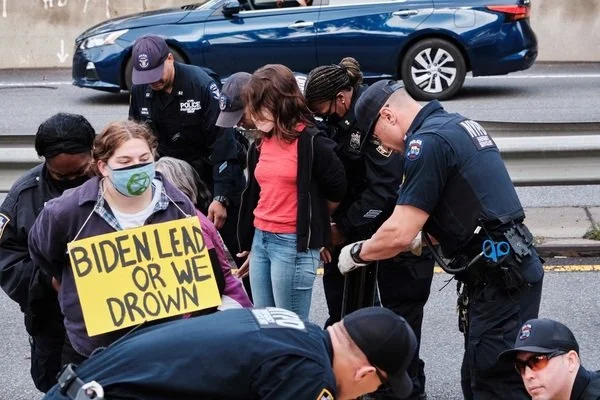Community Statement: More Details About 10/25's Highway Blockade
On Monday, in a collaboration with Sunrise NYC, activists from Extinction Rebellion NYC protested the likely removal of bold climate legislation from the Build Back Better Act. This bill may be our last, best chance at preventing catastrophic climate change, and we take seriously the sidelining of important climate provisions like the Clean Electricity Payment Program. That’s why our action on Monday was so dramatic -- because our city’s, and our world’s, future is at stake.
The response from our community has been tremendous, and we thank all those who have dialogued about the action on our social channels. Check out the conversation here, here, and here.
While we can’t respond to all of your comments individually, we’ve noticed a few recurring points of confusion, and we’d like to clarify them.
The target and purpose of the action
The target of our action was the Biden administration, as well as the government figures who have neglected to take the meaningful, bold climate action we need. Our goal was not to get the attention of commuters but of government officials -- civil disruption helps us do this through extensive media coverage. While we understand and sympathize with those who were inconvenienced by the action, we hope hearing more about Extinction Rebellion’s theory of change will clarify why civil disruption is effective at pressuring leaders when other non-disruptive measures fail.
Extinction Rebellion exists within a tradition of nonviolent direct action (NVDA) going back to the 1960s and beyond. There is a long history of protest groups engaging in disruptive actions that were highly controversial at the time, but have since become regarded as game-changing. For example, the 1963 Children’s Crusade in Birmingham led by Dr. Martin Luther King drew fierce criticism, even from progressives, for allowing children to be the target of police violence. However, the campaign resulted in a major positive shift in the federal government’s stance towards the civil rights struggle. Andrew Manis in his book A Fire You Can’t Put Out writes, “Almost everyone in Birmingham and many throughout the nation were horrified by the use of young people as demonstrators,” including Malcolm X, who said, “Real men don’t put their children on the firing line.” Similarly, the activist group ACT UP (AIDS Coalition to Unleash Power), beginning in the late 1980s, engaged in highly controversial and confrontational actions to publicize the AIDS crisis, which had the desired effect of bringing greater awareness to the issue, though the media deliberately distorted their actions to justify negative coverage.
The media primarily responds to acts of disruption affecting large groups of people, and the current dearth of climate coverage makes it more important than ever to keep the climate crisis front and center. Disruptive actions like that which took place on Monday help Extinction Rebellion increase pressure on governments to act now to create a liveable future for all of us.The science
At least one major media “news” source denied the possibility that New York would be underwater by 2100, and also asserted, contradictorily, that if the sea level rose to that height, the city could somehow handle it. We wish we were exaggerating here, but we’re not. The science is clear: the sea is rising, making it likely that much of New York will end up underwater. And yes, this could happen as early as 2100. The fact that it sounds melodramatic reveals just how dire the crisis is. Read more here and here.
As to the issue of mitigation, the city government recently made a proposal to build a seawall that would cost $119 billion and require 25 years to complete -- but which would, if it works at all -- safeguard only a portion of Lower Manhattan, leaving residents along the rest of the city’s over 500 miles of coastline completely vulnerable. Thus, no plan yet exists that would protect all New Yorkers from both rising seas and coastal flooding -- and if it did, both the logistics of the project and its price tag would be formidable.
In the recent and deadly aftermath to Hurricane Ida, 11 people in the city were drowned in their basement apartments due to flooding. Events like this demonstrate that, as a society, we tend to err in our tendency to regard climate chaos as a future crisis rather than an ongoing and rapidly worsening one. Because the message that the science conveys about the climate is so dire, Extinction Rebellion’s message to the people must be dire, with tactics to match.Safety
Many have raised justifiable concerns about the possible dangers involved in blockading roadways through which emergency vehicles must pass. Extinction Rebellion takes safety seriously, and always ensures that any vehicles involved in a genuine emergency will be allowed to get through. Our goal is to disrupt the status quo, not to add to the suffering that the fossil fuel companies and the politicians that serve them are already causing.
We hope this clarifies some of the points of confusion about Monday’s action, and we encourage you all to stay involved in the conversation. We’re also happy to report that Monday’s action was a huge success! It garnered media coverage from at least 27 sources and sparked countless conversations about climate. We thank those who put their bodies on the line to place climate change at the very center of the public dialogue -- where it belongs.

